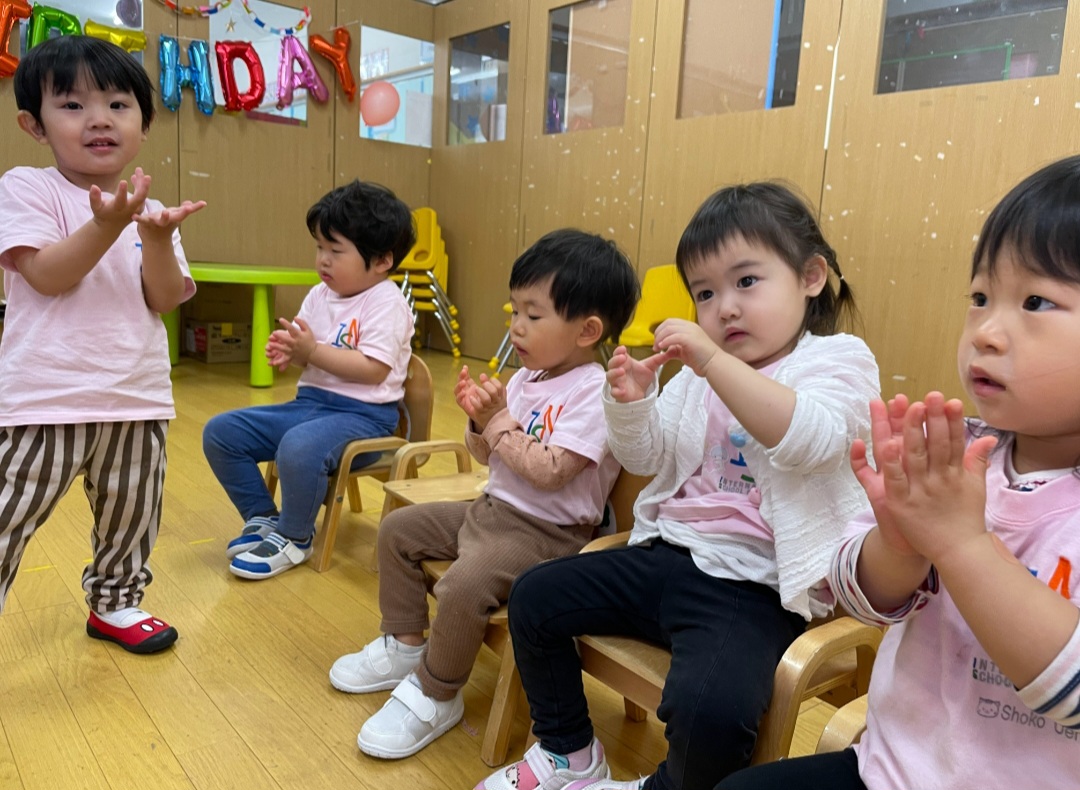南松本キャンパス園児の音楽レッスンについてです。
就学前の子供たちには、リトミックを中心とした音楽教育と、年少児後半からは、ピアニカを導入したレッスンを行っております。
リトミックとは、スイスの音楽教育家で作曲家でもあった、エミール・ジャック・ダルクローズにより草案された教育法で、動きを通じて音楽の諸概念を教えるという理論に基づいています。
ただ、彼はその著書の中で「リズム運動を教える事は音楽を基盤とするものではあるが、単に音楽学習に留まらず、むしろそれ以上に一般教養の一大体系なのである。」と述べている通り、決して音楽教育だけの教育ではないのです。
音楽を楽しみながら学習する事によって、子供たちのリズム感や音感を育み音楽的能力を養うと共に、集中力、注意力、記憶力、思考力、想像力、即時反応力、等の基礎的能力を高める事が期待できます。
即時反応表現の活動は、次は何、その次は何、と決められていません。リトミックがお遊戯と違う点はここにあります。
何を表現するにも音楽を良く聴き、その音楽の変化に即時的に反応しながら表現していきます。音楽が言葉となって働きかけるのです。
これが、集中力や注意力、反応力などを高める事に繋がります。
音楽レッスンを通じて、子供たちの様々な能力を高める事に貢献出来ればこれほど嬉しい事はありません。
レッスン内容の一例として、今年度の年少児、四月のプログラムの一部を紹介いたします。
〇トントントンどなたです
ドアが沢山ある大きなお家の絵を子供たちに見せます。これは動物さんが住んでいるお家です。沢山のドアがありそれぞれ動物さんが中に居ます。
皆でドアをトントンして、誰が居るのか確かめてみましょう。
子供たちは「トントントンどなたです」とメロディーに合わせて歌いながら、トントントンの部分でリズムに合わせてカスタネットを叩きます。
初めは、カスタネットを持った事が嬉しくて、やみくもに叩いていた子供たち。
次第にリズム通りに叩ける子が増え、トントントンのところ以外ではカスタネットを鳴らさない、という事も出来るようになってきました。
簡単に音の出る楽しい楽器を持って、鳴らす事を我慢するのは容易ではありません。
でも、皆でピタッとカッコよく揃った時の気持ち良さも分かる子供たちです。
こうして音楽だけでなく「我慢する」事を学んでいるのです。
上手に出来たら、ドアが開きます。豚さんが現れました。
「私はブタです、ブーブーブー」とこれもメロディーに合わせて歌いながら、今度はブーブーブーのところで、リズムに合わせてカスタネットを叩きます。
四月は、ブタさんとネコさんが登場しましたが、この後更にヒツジさん(メーメーメー)
サルさん(ウッキッキー、と動作を交えながら)、ウサギさん(ピョンピョンピョンとリズムに合わせてジャンプ)、など様々な動物の歌に合わせてリズム活動をする予定です。
〇カラーボードによる活動
様々な色のカラーボードをそれぞれが持ち、ピアノのメロディーと共に走ります。
子供たちは走る事が大好きで嬉々として駆け回っています。
突然音楽が止まったら、動きもストップ。指導者が指示した身体の場所に素早くカラーボードを当てます。
音楽が止まっている間は動いてはいけません。
この活動は、即時反応力や集中力を養い、自己をコントロールする(我慢する)力も育てます。
〇みなさんとお散歩
「みなさんとおさんぽ」のお歌に合わせて、みんなでお散歩します。
この時、4分音符に合わせ、リズム通りに動きます。
スイングの音楽に変わったら、両手両足を大きく広げてスイングです。
こちらは二分音符の速さに合わせて動きます。
もう一つ、速い音楽(八分音符)では走ります。こちらは(この年齢ではまだ)リズムを気にせず自由に走って構いません。
この活動によって、音価を身体で感じ表現する事が出来ます。
音楽を良く聴き、音楽が変わったら即座にその動きをする、という活動を通して、集中力や即時反応力も鍛えられます。
〇南の島のハメハメハ大王
子供たちが大好きな、歌詞や言葉のリズムが楽しいこの曲に合わせて、振りをつけて踊ります。
幾度となく出てくる「ハメハメハー、ハメハメハー、ハメハメハメハメハー」の部分は、手を前に出し「パーグーパー、パーグーパー、パーグーパーグーパー」とリズムを取ります。
これは子供たちにとってなかなか難しく、まだ上手く出来ないお友達も居ますが、とても楽しい曲なので、来月も引き続きこの曲を扱っていこうと思っています。
このような活動は、本来のリトミックとはまた違ったものになりますが、普段英語のみで活動している子供にとって、日本語の歌に親しむ機会になると共に、リズム感や協調性を育てます。
これらは、活動のごく一部ですが、各クラス、子供たちの様子を見ながら毎月新しいプログラムを提供しています。
音楽を通じて子供たちの成長を長いスパンで応援出来ることは、私達にとってもとても楽しく嬉しい事です。
We are writing about the music lesson for the students of the ISN Minami Matsumoto campus.
The music lessons for preschool children are centered around rhythmic education.
Rhythmic is the teaching of music theory concepts through exercise and movement, created by the Swiss music composer and educator Emile Jaques-Lacroze.
He is known for saying that “although teaching rhythmics is based on music, it`s more than just a music lesson, it is just another system of general education.”
By learning while enjoying music, we are able to develop the childrens` sense of rhythm and music ability in order to enhance their other basic abilities, such as concentration, attention, memory, thinking, imagination, response power etc.
In music lessons, music acts as words. The children listen to music and respond to the changes they hear in the music. This leads to an increase in the ability to focus, react, be attentive etc.
There is nothing better than contributing to the various abilities of the children through music lessons.
As an example of lesson contents, below we will introduce a part of the ISN music program for April 2018.
- “Ton Ton Ton”
The children are shown an image of a large house with many doors. This the house where animals leave, one animal in each of the doors.
The children “go through” the door and see who lives in there. Children sing the melody of “Ton Ton Ton, who are you?), tapping the castanets according to the rhythm of the song.
At the very start of the lesson, most of the children are hitting the castanets blindly, but as the lesson progresses, they learn to clap according to the beat. It is an instrument that is easy to hold, but also fun to play and make music with. However, the true joy for the children is seen when everyone alligns the sounds they are making to the music together. In this way, they are not only learning music, but patience and perseverance as well.
If they do their task well, the door of the big house opens. A pig appears. The pig sings its song and the children play the castanets to the beat of the pig`s song too.
In April, pigs and cats appeared in the house, but in May, a sheep began to appear as well, making its own noises (baa-baa-baa). Soon, we are planning to perform rhythm activities following the songs of many various animals (monkeys, rabbits etc.).
- “Colour board activities”
Each colour board has a variety of colours and children run on it, following the melody. Suddenly the music stops and the children have to stop as well. Through this activity, the children practice instant reactivity and concentration, as well as patience.
- “A walk with everyone”
The children move to the rhythm of the song, doing different movements, according to the tempo of the music they hear. Through this activity, the practise to represent the value of the sounds with their bodies. Also, because they are carefully listening to the music and planning their next move, they are concentrated and respond immediately.
- “The Great Hamehameha of the Southern Island”
The children dance along to the rhythm of this song that they know and love, clapping to the rythm as the song goes along. This is a very difficult song for young children, so some students are still not fully capable of doing it very well, but we will continue practising it throughout the coming months as well.
This type of songs also enables the students who have been in an English language school their whole life to become familiar with traditional Japanese childrens` songs and activities as well.
This is just a small part of all the activities we do, as we offer new programs each month, but they are a representation of what we do. It gives us great pleasure to be able to support the childrens` continuous progress through music as well.




